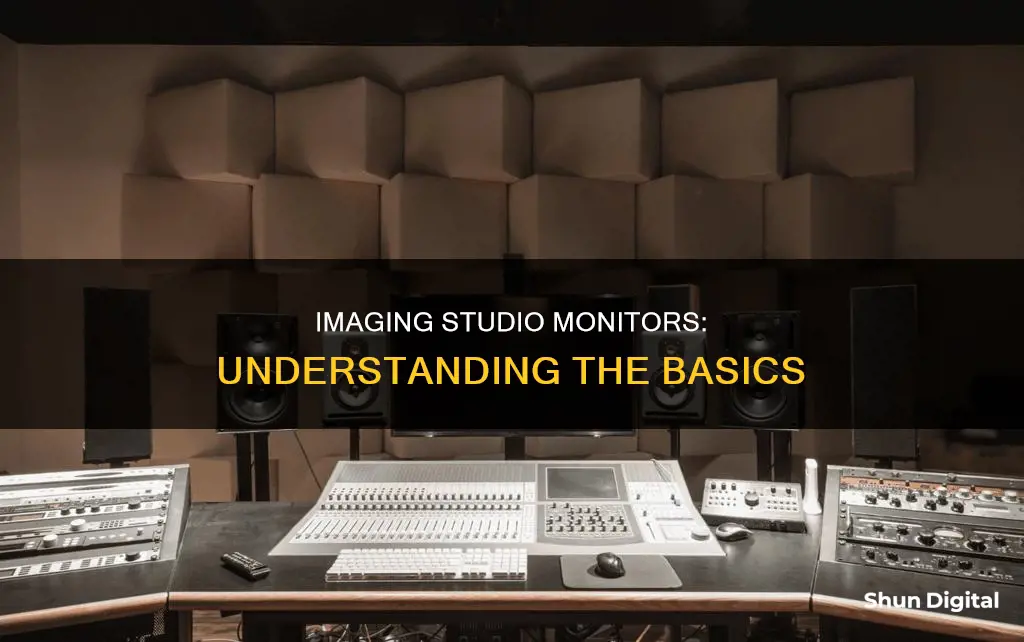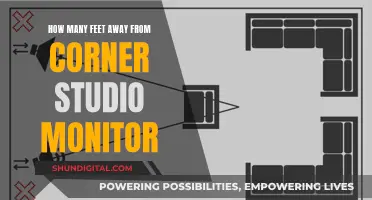
Studio monitors are loudspeakers used for critical listening during the recording, mixing, and mastering process. They are designed to reproduce sound as accurately as possible, with a flat frequency response and minimal distortion. This means that all frequencies are played at the same volume level, without any emphasis or de-emphasis on particular frequencies. Studio monitors are typically used in recording studios, film-making, television studios, radio studios, and home studios, where accurate audio reproduction is crucial. They are often placed on stands or a mixing console, with the listener seated a few feet away, to create a neutral listening environment. The size and type of studio monitor depend on factors such as room size, music style, and budget.
| Characteristics | Values |
|---|---|
| Purpose | Critical listening during recording, mixing, and mastering |
| Use | Audio and music production |
| Design | To create an accurate representation of the audio signal |
| Frequency response | Flat |
| Phase linearity | Linear phase relationship |
| Amplification | Active or passive |
| Speaker type | Near-field, mid-field, or far-field |
| Speaker size | 3.5 inch, 4 inch, 4.5 inch, 5 inch, 7 inch, 8 inch, or larger |
| Max SPL | Measured in dB SPL |
| Frequency range | 20 Hz to 20 kHz |
| Total harmonic distortion | Less than 3 dB |
What You'll Learn

Stereo imaging
To achieve excellent stereo imaging, studio monitors should have phase-linearity and perfect time alignment (group delay) across the entire frequency range. This ensures that the speakers deliver sound waves to the listener's ears in a synchronised manner, creating a cohesive and immersive soundscape. Point-source speakers, such as coaxial or single-driver designs, are often considered ideal for achieving precise stereo imaging. These speakers emit sound from a single point, reducing the complexity of wave interactions and minimising phase issues.
However, achieving perfect stereo imaging is challenging, especially in near-field monitoring setups. The interaction between the speakers and the room acoustics plays a significant role in the overall sound experience. Reflections, reverberations, and the shape of the room can all impact the stereo imaging. To optimise stereo imaging, it is essential to consider not only the speaker design but also the room's acoustics, including the placement of the speakers within the space.
Some studio monitors are designed with advanced features to enhance stereo imaging. For example, the PreSonus Sceptre S8 studio monitor features a coaxial design with a horn-loaded titanium compression driver tweeter mounted inside a fibreglass-treated paper woofer. This combination, along with DSP to reduce nasal colouration, provides exceptional 3D imaging for its price point.
Ultimately, the choice of studio monitor depends on various factors, including room acoustics, budget, and specific requirements. While some monitors may excel in stereo imaging, it is essential to consider the overall sound quality, accuracy, and reliability of the speakers to make an informed decision.
Audi A4: Blind Spot Monitoring Feature Explained
You may want to see also

Nearfield, mid-field, and far-field monitors
Studio monitors are loudspeakers in speaker enclosures specifically designed for professional audio production applications. They are used in recording studios, filmmaking, television studios, radio studios, and home studios.
There are three main categories of studio monitors: near-field, mid-field, and far-field. Each type has unique characteristics and strengths, catering to different studio sizes and audio requirements.
Near-Field Monitors
Near-field monitors are designed for close-range listening, typically within 2 to 5 feet of the listener. They are compact and ideal for smaller studios or spaces where sound detail and accuracy are crucial. Near-field monitors excel at isolating sound, minimising interference from ambient noise or other sound sources. This makes them perfect for mixing and mastering tasks, allowing users to hear individual track elements clearly. They are commonly used in home studios, editing suites, and radio broadcast booths.
Mid-Field Monitors
Mid-field monitors are larger than near-field monitors and are placed between 5 to 8 feet from the listener. They can handle higher volume levels and deliver a more full-bodied sound, making them suitable for mixing in larger spaces or studios requiring increased volume. Mid-field monitors provide a more natural sound than near-field monitors while maintaining a controlled dispersion pattern. They are more forgiving of room acoustics, making them versatile for studios with less-than-ideal sound conditions. These monitors are a good choice for those working across multiple music genres, as they offer a balanced and neutral sound.
Far-Field Monitors
Far-field monitors are the largest of the three types and are positioned at a distance of 10 to 20 feet or more from the listener. They are designed for large recording studios, concert halls, and performance spaces. Far-field monitors can produce high volume levels without distortion, making them ideal for monitoring and mixing in expansive areas. They offer a more relaxed sound, which can be advantageous for extended listening sessions.
The choice between near-field, mid-field, and far-field monitors depends on the size of the listening space, budget, and personal preferences. Near-field monitors are ideal for smaller spaces and critical listening, while mid-field monitors excel in larger spaces with higher volume requirements. Far-field monitors are the preferred option for substantial performance venues and studios needing high volume outputs and a relaxed sound.
Wondering About WRX Premium: Blind Spot Monitoring Feature?
You may want to see also

Active vs passive monitors
Studio monitors are loudspeakers in speaker enclosures designed for professional audio production applications. They are used to mix music, dialogue, and sound effects during the recording, mixing, and mastering process.
Studio monitors can be either active or passive. Active monitors have built-in amplifiers, while passive monitors require external amplifiers. Here are some key differences between the two:
Active Monitors:
- Simpler to use: They are easy to set up and don't require any additional equipment, making them a plug-and-play solution.
- Optimised amplifiers: Active monitors have amplifiers specifically designed for and tuned to the speakers, resulting in better overall sound quality.
- Bi-amp and tri-amp configurations: These configurations provide better control over frequency response and more precise sound reproduction. In bi-amp, each driver has its own dedicated amplifier. Tri-amp takes it further by dedicating an amplifier to each driver for low, mid, and high frequencies.
- User-adjustable EQ tweaks: This feature helps match the speaker to the room, although it can be more trouble than it's worth in inexperienced hands.
- Convenience and performance: Active monitors offer both convenience and performance, making them a popular choice for professional studios.
Passive Monitors:
- More flexible: With passive monitors, you can choose an external amplifier that perfectly matches your monitors' power rating and impedance.
- Gradual upgrades: With passive monitors, you can upgrade the speakers and amplifiers separately, allowing for a more gradual and cost-effective progression to better-quality gear.
- Cost-effective: Passive monitors can be more cost-effective, especially when coupled with a good-quality second-hand amplifier.
While active monitors offer convenience and optimised performance, passive monitors provide flexibility and the ability to make gradual upgrades. The choice between the two depends on your specific needs and preferences.
Monitoring Bandwidth Usage: Cisco 3560 Switches
You may want to see also

Amplifier configurations
The single-amp configuration is the simplest setup, where the left and right speakers are powered by a single amplifier integrated into one of the speakers. This configuration is commonly used for computer speakers but is rarely used for studio monitors.
The bi-amp configuration, on the other hand, is more common in professional studios, as it offers greater control over the frequency response and more precise sound reproduction. In this setup, each speaker has two amplifier modules, and in a 2-way design, each driver has its own dedicated amplifier. This allows for a more accurate and detailed sound, which is crucial for critical listening and mixing in studios.
The tri-amp configuration is the most advanced and complex of the three. In this setup, each driver in a 3-way speaker system (woofer, midrange, and tweeter) has its own dedicated amplifier, allowing for ultimate control over the frequency response and precise sound reproduction. This configuration is typically used in high-end professional studios where the highest level of accuracy is required.
The choice between these amplifier configurations depends on the specific needs and requirements of the studio setup. Single-amp configurations are simple and cost-effective, while bi-amp and tri-amp configurations offer more precise control over the sound and are better suited for critical listening and mixing applications.
Choosing Studio Monitors: What to Consider for Quality Audio
You may want to see also

Monitor size and wattage
Studio monitors are loudspeakers designed for professional audio production applications. They are used to mix music, dialogue, and sound effects during the recording, mixing, and mastering process.
The size of studio monitors should align with the room size and music style. For instance, 5-inch woofers are a good fit for home studios. If you are an EDM music producer, you will require a better low-frequency response, and therefore a bigger driver size would be more suitable. This is because larger speakers can move more air, which is necessary for reproducing lower-frequency sounds.
Wattage determines the monitor's ability to deliver adequate sound levels without distortion. If you are just starting out or working in a small-to-medium-sized room, a studio monitor with 50-75 watts per channel should be sufficient. However, if you are in a big commercial studio, you might want to consider something with more wattage, like 100 watts or more per channel.
It is important to note that wattage is not the only factor that determines sound quality. Other factors, such as driver quality, amplifier power, and speaker placement, can also have a significant impact on the overall sound of your studio setup.
Best Place to Buy the Omron BP652N Wrist Monitor
You may want to see also
Frequently asked questions
Studio monitors are loudspeakers in speaker enclosures specifically designed for professional audio production applications. They are used for critical listening during recording, mixing, and mastering. Studio monitors are made in a more physically robust manner than home hi-fi loudspeakers and are used for listening at shorter distances.
Studio monitors are designed to have a flat frequency response, meaning all frequencies are played at the same volume level. This is important for accurately balancing the levels of different frequencies in the audio. Regular Hi-Fi speakers, on the other hand, are "biased" to emphasise certain frequencies, such as adding more bass to music. Studio monitors are also almost always active, meaning they have a power amplifier built into the speaker.
Active studio monitors have built-in amplifiers, which means you don't need an external amplifier to use them. Passive monitors, on the other hand, require an external amplifier. Active monitors are simpler to set up and are more reliable and accurate, while passive monitors offer more flexibility as you can choose an external amplifier to match your specific needs.







